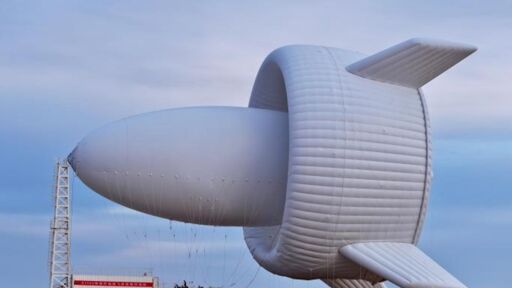"High-altitude winds between 1,640 and 3,281 feet (500 and 10,000 meters) above the ground are stronger and steadier than surface winds. These winds are abundant, widely available, and carbon-free.
"The physics of wind power makes this resource extremely valuable. “When wind speed doubles, the energy it carries increases eightfold, triple the speed, and you have 27 times the energy,” explained Gong Zeqi "
1,640 and 3,281 feet (500 and 10,000 meters)
I feel like this needs a second look.
As a European… Are feet logarithmic? Wouldn’t even surprise me that much.
Only when viewed from the north.
And on Tuesdays.
No, but feet are analogue. Hands are digital.
The zero key got stuck.
They used different people’s feet.
Chinese feet are smaller.
So that “10,000 meters” didn’t scale right, clearly. But you also can’t possibly call those “high altitudes”. Small planes like cessnas fly at low altitudes, like 2,000 - 5000 ft, a 747 flys at a high altitude, 40,000 ft; 1600 ft is nothing, that’s lower than some buildings.
they’re talking about the extra 0 on 10,000
I did catch that, I was just pointing out there are additional problems with the statement as well. But I’ve edited my statement to make that more clear.
Agreed. I had the same thought and then saw the numbers and was like wait, “which part of this is the fucked up part?”
Ha! Watch us burn some liquid dinosaurs!
- USA
Fossil fuels are from shit the dinos ate, like plants and other dumb crap. The belief that coal-rollers are cool enough to burn liquid dinosaurs is easily the single biggest lie of the oil industry.
Closely followed by -gestures wildly-
Lol, got your new advert campaign… Gasoline is vegan
I mean, they already rebranded some shitty vinyl as “vegan leather”.
That might actually stop the conservatives from using it.
Oil is solar power with extra steps.
Just cut out the 300 million year old middle man
I mean some small part of it is dino. But yeah by biomass it’s mostly plant.
Fun fact , oil is mostly from carboniferous period , so its alot older than dinos … few hunder million years older
Isnt all feces by definition dumb because of lack of advanced functioning brain?
Maybe yours is. Mine isn’t because I’m a smartass
The whole term fossil fuel is wrong.
And Africa, and South America, and the middle east, and Europe. Don’t pretend the rest of the world isn’t still burning fossil fuels it’s not just the US
Finally the stupid floating jet engine looking turbines from Big Hero 6, except IRL they actually look good.

deleted by creator
Incredible progress on a concept that has been seeking investment for last 15 years. It doesn’t just provide 1.2mw, it also operates at a higher capacity factor than capturing winds closer to ground. I’m sure it can scale even higher.
This is useful for clean energy shipping. Design supports an unthethered airship that produces H2 and transports it at the same time. I believe the design would support forward momentum directly upwind, but some tacking angle would be supported.
This is not just a breakthrough in wind energy generation, it is a breakthrough in airship capability.
Meanwhile in the US, rich assholes are firmly convinced coal and oil are the future.
God I hate this place.
It’s late stage capitalism.
These fools are just hoarding what they have and trying to continue the « golden age ».
China will be the next superpower for sure
To be fair, coal and oil are narratives are being pushed by foreign actors too on the US. China knows exactly how to win a race, and step 1 is to tie your opponents’ shoe laces.
An untethered AWE cannot produce any power
Contentious. Thethering increases power production by restricting the “sail movement power”. The blimp part is highly/perfectly aerodynamic, and the betz limit means that a turbine does not fully “act like a parachute”. Ground vehicles that proved faster than wind speed directly upwind could use similar principle to turn a propulsion prop, that increases forward/apparent wind speed generating more power.
This relates to same incredulity for faster than wind upwind ground experiment, and needs experimental proof. But principles of sailing are indeed magical, and simply generating enough power to move forward is extremely useful, even if tacking were needed.
In all your examples there is the ground to provide a counteracting force. Maybe I am misunderstanding what you mean by untethered, but any initial airspeed difference between the wind and your system will eventually vanish and you’ll move along with the surrounding air.
I co-founded an AWE startup 8 years ago and let me tell you, literature does not support your claim.
Also, it looks cool as fuck!
…produces H2?
electrolysis of water (partially from starting water reservoir, and partially from air humidity = dehumidifier step), can displace water weight with increased H2 pressure in airship. Can put an infinite amount of these over ocean with no land lease costs, but moving giant ships solves the issue of thethering them.
This looks like a good way to bring power to a remote area, and China has lots of those.
Say what you will at least China seems produce some much needed tech in exchange for selling their people to capitalism, the latter which almost all countries do but in exchange for funnelling the 99.99 % of the revenue to billionaires and/or war (pulled the stats out of my hass).
Switching to renewables makes a lot of sense from an economic and ecologic point of view but also geostrategically. Unfortunately, Western governments have pretty much lost the ability to act on those considerations. This is due to then being beholden to a few billionaires who would rather see civilisation as we know it end than accept a few percentage points revenue drop for a couple of quarters.
It’s because the regulatory bodies are captured by the interests of the fossil fuel companies
They aren’t limited by democracy.
This is a factual statement. Whether people like how it sounds or not.
It is true, though lacking fail safes of a real democracy is a dangerous game to play in the long term, even if technically positive in an instance. As most autocratic leaders seek to gain continuous and more power. Or their predecessor does.
It’s a novel approach, but the Chinese aren’t the only ones trying to harvest energy from high winds: https://skysails-power.com/how-power-kites-work/
Promising concept too, but this is 250-500x the scale of that.
How so, when skysails talks about “Venyo harnesses the power of high-altitude winds with speeds of 13 m/s and a continuous output of up to 200 kW.” while the S1500 is featured with “Inside this duct are 12 turbine-generator sets, each rated at 100 kW.”?
It’s more like factor 5-6.Their v2 product produces about 5kw at much lower altitude (weaker 9m/s winds). 13m/s is a big ask. They don’t go as high as 1000m. I was comparing to their v2 product instead of the 200w theoretical max of their v1 product. But the blimp may not produce 1.2mw all the time either.
Yah, we need to have them running to get real numbers.
I find both approaches promising.
Ways to make electric energy available without burning fossil fuel are good.
What matters is scalability and how much material and cost you need to produce per energy unit. Kites (either parasails or fixed wing) are much simpler, can be scaled up too, and you only need a simple cable that pulls the generator’s winch. Overall kites seem much more efficient to scale up.
That looks complicated and frankly kind of stupid. Imagine trying to get something like that working without having an engineer standing by that can get everything fixed once it crashes down or something else like that happens.
IDK, the benefit to the goofy kite design is that the aerial portion is far simpler - and there’s no massive energized cable hanging in the air. It’s a little… non-conventional, but it’s a great deal less complicated than floating a massive generator like the chinese solution. Downside is presumably lower energy density per unit, but the reduction in operational footprint might make the two designs competitive. It’s good people are exploring both options!
The simpler design might lead to lower prices per kWh, which will in the end play a role together with reliability, e.g min/avg power output, durability, outages.
I find it impressive how creative engineers get. Let’s hope for a third option ;)
Fair, but please name one single way to generate that kind of electrical power that can be fixed by a layperson in case something crashes.
At least the Chinese version doesn’t rely on as many moving parts to keep it aloft. And a complicated mechanical system to produce a flight path. The blimp itself is complicated, but it’s not a kite.
In the end the TCO (per kWh) will play a major role, especially for big installations and for smaller ones the price floor.
I suppose a helium filled blimp with 12 turbines will be more pricey than a kite with a generator. If the kite fills your need, pick that.
I’d be more interested about the cable that is going to bring all that power to the ground level. With traditional tech that would weigh a shit-ton. Light weight generator would be easy peasy compared to that.
Maybe over estimate temperature deratings and maybe add a new wind speed thermal pulling capacity. But more likely forgo European and NA electrical standards entirely and submit questionables value for CE approval.
Maybe there’s energy intensive processes that they could do up there instead. Something like Haber Bosch. Then bring the products down.
City in the clouds
Will it be run by Billy Dee Williams?
Where they’re keeping my crew.
@Hodor@sh.itjust.works @iii@mander.xyz
Or, even better (considering how data centers are getting increasingly power-hungry): cloud in the clouds!
Microwave death ray to beam it down could be fun.
Local residents metallic objects would shoot sparks every now and then.
They should do a Nikola Tesla and transmit electricity wirelessly
Edit: I was trying to get more information from other articles and got the S1000 (100kW) mixed up with the S1500 (1000kW)
They’re trying to get it to100kW. That’s like a pretty big generator but not a huge one. So this isn’t a replacement for wind farms just yet. The picture is from a year ago. No mention of costs.Would it be possible to use heat to get it to float, instead of helium? Heat it up with electricity.
The article says:
The S1500 features a main airfoil and an annular wing that together form a giant duct. Inside this duct are 12 turbine-generator sets, each rated at 100 kW.
That suggests to me (admittedly a layman) that each blimp is more like 1.2MW?
The title itself already says it’s 1MW.
Sorry about that, I got all excited at just a tenth of what they are trying to achieve. Oops
It’s all good mate, we’ve all got over excited at times.
Would it be possible to use heat to get it to float, instead of helium? Heat it up with electricity.
Sure, that would be possible. The generators themselves will produce some amount of heat. It’s also going to have a fair amount of passive lift, as it’s essentially a kite. So simply being able to maintain a rigid shape and effective airfoil could do a lot to produce the desired lift. If it were redesigned with that in mind, shaped more like a glider/kite/parasail, something to maximize lift, it’s possible that it could be done without a light gas, though it would also be more reliant on favorable winds.
I have to wonder though, how much the power transmission lines weigh, that seems like a serious limiting factor on maximum attainable altitude.
The transmission line question is interesting though, there’s a complex optimization problem there. Traditionally with wind, larger turbines are more efficient. As you increase the turbine blade size, the area that the blades cover (and thus power generation potential) increases more than the mass of the blades do. So the result is (generally speaking) a larger wind turbine is more efficient than a smaller one. But now factor in the transmission line… The larger the turbine the more power it generates AND the thicker (and heavier) the transmission line has to be for its entire length. To complicate things more, higher altitudes mean stronger and more reliable wind. So now how do you optimize for turbine size/cable gauge, and cable length/altitude?
It seems tricky, but like perhaps there’s just a right answer, an optimal size.
Can they preference the generation to favor voltage over current? Current is what tends to need really thick cables.
Using hot air instead of helium would not work. The density of hot air is much higher than helium, so you would need a significantly larger airship to lift the same mass of payload (the useful bits). That and keeping the air hot would require constant energy input reducing the efficiency of the system dramatically. I’m pretty sure that system would be literally impossible to construct.
Hydrogen is simply the right lifting gas. Helium not abundant enough for sustainable scale. AFAIK, this model did use H2. Previous protototypes used helium.
it is 1.2mw = 12x100kw
Did they actually generate power during the test flight?
“demonstrated 1mw production” from other sources.
[face Palm].
JFC people, take a grade 10 physics class.
How about you take a ninth-grade speech class first?
Neat.
Any real reason you can’t fill them with hydrogen? A fire can’t start inside the bubble, because there’s no oxygen. If a fire starts on the outer surface, then it doesn’t really matter if it’s hydrogen or not. It’s also cheaper and slightly better at lifting. There is some more danger with handling it on the ground, but you should be able to mitigate that with safety procedures.
Yes the Hindenburg disaster had more to do with the flammable paint used than the hydrogen inside it. But the safety procedures when working with on the ground may be more expensive than just using helium.
Hydrogen is hard to contains long term, it leaks through most materials. I’m no expert on the matter but I suspect the gains in lift would be partly negated by the changes to the envelope of the container.
When wind speed doubles, the energy it carries increases eightfold,
Edit: I’m wrong, see edit below!
Huh? Kinetic energy increase is square, not cubic.
KE=1/2 m v^2
So every doubling of speed should increase the available kinetic energy by 4 times, not 8. 3 times the speed is 9 times the energy. Granted there are probably some efficiency gains in excess of this at the low end,
but as a rule that’s just wrong.Edit: Cool, I learned something new! I neglected to consider it in terms of power, just thought about kinetic energy.
So something like: KE = 1/2 m v^2
= 1/2 ( rho V) v^2
= 1/2 ( rho A d) (d/t)^2
= 1/2 rho A d^3 1/t^2
Where P = KE/t
Thus:
P = 1/2 rho A (d/t)^3
= 1/2 rho A v^3
Lots of other aspects I’m sure I have wrong, but I see how the cubic came to be.
Its cubic actually
https://thundersaidenergy.com/downloads/wind-power-impacts-of-larger-turbines/
I don’t understand the physics, but every model of power output from wind turbines uses V^3 for the formula
That’s a good link.
During the stampede scene in the Lion King, imagine the wildebeests were stampeding twice as fast. Then Simba’s dad Mufasa would not only have quadruple the amount of energy imparted by each wildebeest, but also be trampled by twice as many wildebeests per second, so the rate of energy imparted on Mufasa per second would be 4 x 2 = 8 times greater when velocity doubles.
Education via childhood trauma
Thanks for the correction! I got way ahead of myself.
thx for the link! just spent the last hr reading about windmills. and although I live in a country full of them I’ve often wondered, but never really paused to ponder about the intricacies that go into windmill design. fascinating stuff!
I work with statistics and joined a wind power forecast project, so I have been reading papers on wind power generation for the past month. There’s other more complex formulas that the one shared on the link, but that was the first I found not pay walled.
Increasing the speed increases both the kinetic energy of the wind hitting the turbines and the amount of wind that hits the turbines each second.
It has to do with type of turbine that uses “airfoil principle”. Your formula works for “cup”/Parachute design, but airfoils/upwind sails are “magic”
I’m out of practice with my physics so apologies if this is a n00b question, but:
I’m unclear what (rho V) is and how you converted to that from mass (m). Further unclear what (rho A d) refers to.
Can you explain / link to an explainer on this?
Rho is density
We don’t directly harvest the kinetic energy. That increase probably has to do with how the wind provides lift to the blades. Of course, you couldn’t keep increasing like that until the harvested energy is greater than the kinetic energy. But I’m sure at any wind speed we only get a tiny fraction.
TIL thanks for bringing this up
This thread is telling me one thing and one thing only: I need to see Big Hero 6…
You don’t need to, but your life will have been without purpose if you don’t see it. Kidding, but I did see it for the first time last year, and it was pretty good
It looks like a boss bloon from BTD6 lol
Saw this in Big Hero Six. It’s a crazy concept. Hopefully it works.
This is totally breaking loose and heading toward the nearest city in the final act.























